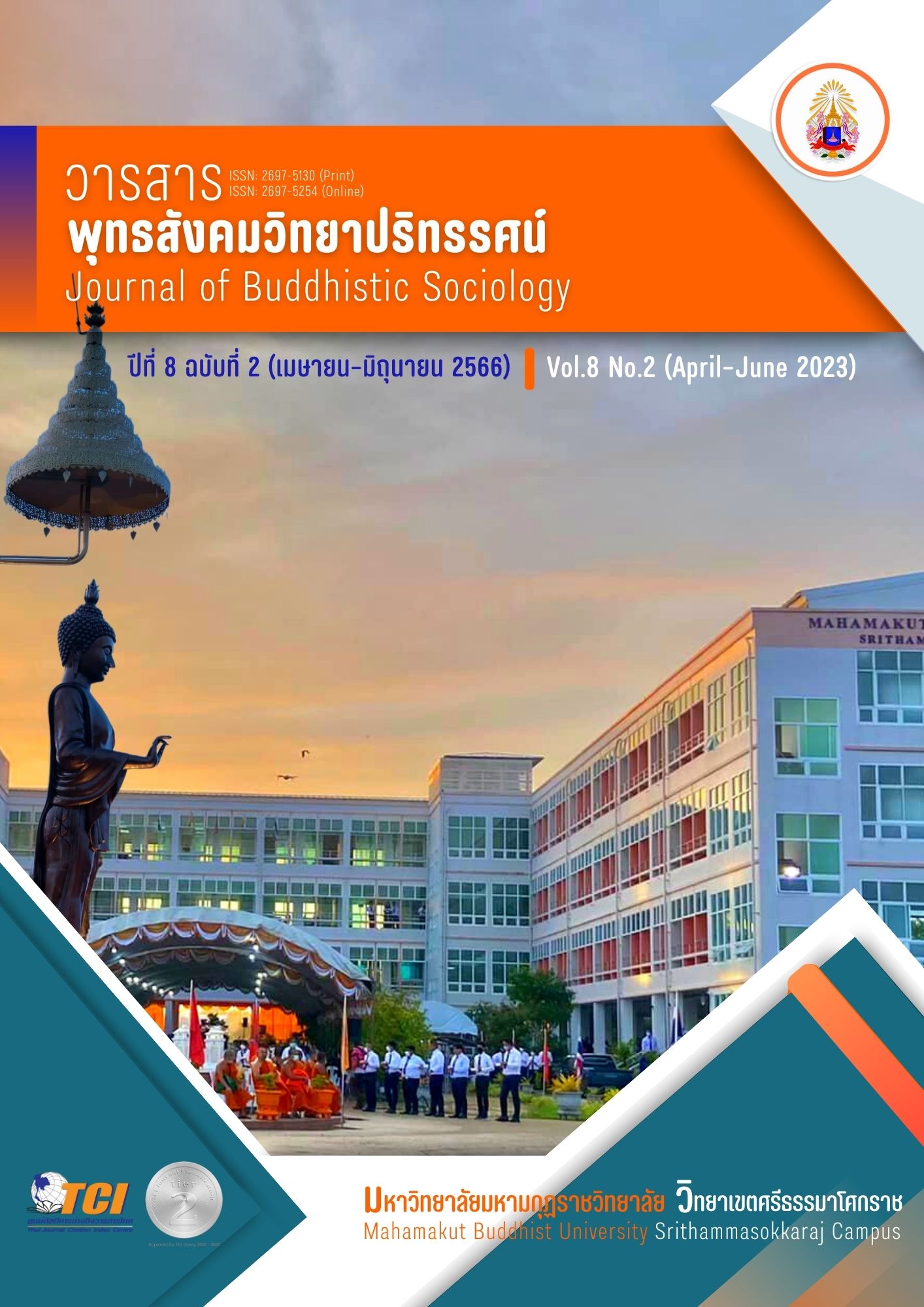AN APPLICATION OF TRI-SIKKHA IN LIFE QUALITY DEVERLOPMENT OF PEOPLE IN KLONGKHUD SUB-DISTRICT COMMUNITY MUANG SATUN DISTRICT, SATUN PROVINCE
Main Article Content
Abstract
This thesis has the following objectives: 1) to study the application of the Trisikkha in improving people's quality of life 2) to compare the application of the trisikkha in improving the people's quality of life 3) to study suggestions and guidelines for applying the trisikkha in Improving the quality of life of the people It was a mixed research study. The population consisted of 18, 947 people in Klong Khut Subdistrict, Mueang Satun District, Satun Province, 392 quantitative samples, 5 qualitative samples. The tools used to collect data were questionnaires and interviews. Data was analyzed using the program. The statistics used for data analysis were percentage, mean, and standard deviation. t test statistic F test statistic Paired mean by Zeffe's least significant difference method. by analytical method one-way variance
The research results showed that;
1. The application of the Trisikkha in improving the quality of life of the people as a whole was at a medium level. When considering each side in descending order, it was found that people in the community applied the Trisikkha to improve their quality of life. The precepts have the highest averages. followed by meditation The intellectual aspect had the lowest average.
2. Comparative results of the application of the Threefold Trisikkha to improve people's quality of life Classified by general data, it was found that people with different sex, occupation, level of education and annual income were different. Applying the Threefold Differently People of different ages Applying the threefold is no different. significantly
3. Suggestions and guidelines for applying the Threefold in the development of the people's quality of life found that, in general, people should be encouraged to behave well physically, verbally and mentally according to religious principles. make people moral firmly established in the nation, religion, monarchy, filial piety, adhering to Thai arts and culture
Article Details

This work is licensed under a Creative Commons Attribution-NonCommercial-NoDerivatives 4.0 International License.
References
บรรเทา กิตติศักดิ์. (2536). การอ่านและพิจารณาหนังสือ. กรุงเทพมหานคร: ไทยวัฒนาพาณิช.
ประเวศ วะสี. (2547). ธรรมชาติของสรรพสิ่ง: การเข้าถึงความจริงทั้งหมด. กรุงเทพมหานคร: โรงพิมพ์มูลนิธิสดศรี - สฤษดิ์วงศ์.
พระธรรมปิฎก (ป. อ. ปยุตฺโต). (2545). รุ่งอรุณของการศึกษา เบิกฟ้าแห่งการพัฒนาที่ยั่งยืน. กรุงเทพมหานคร: โรงพิมพ์สหธรรมิก.
พระมหาจักรพันธ์ จกฺกวโร. (2563). การพัฒนาศักยภาพและโอกาสทางการศึกษาของเยาวชนบนพื้นที่ราบสูงในจังหวัดตาก. วารสารปัญญาปณิธาน, 5(1), 119-131.
พระมหาโยธิน มหาวีโร (มาศสุข) และคณะ. (2565). ศึกษาการจัดการเรียนการสอนตามหลักไตรสิกขาสำหรับนักศึกษาระดับปริญญาตรี มหาวิทยาลัยมหามกุฏราชวิทยาลัย วิทยาเขตศรีธรรมาโศกราช. วารสารพุทธสังคมวิทยาปริทรรศน์, 7(3), 65-80.
พระราชวรมุนี (ป. อ. ปยุตฺโต). (2530). ทางสายกลางแห่งของการศึกษาไทย. กรุงเทพมหานคร: อมรินทร์.
ไพรัตน์ ญาติฉิมพลี. (2540). การเปรียบเทียบผลสัมฤทธิ์ทางการเรียนและการให้เหตุผล เชิงจริยธรรมของนักเรียนชั้นมัธยมศึกษาปีที่ 1 ที่เรียนวิชาพระพุทธศาสนา โดยการสอนแบบไตรสิกขากับการสอนตามคู่มือครู. ใน ปริญญานิพนธ์การศึกษามหาบัณฑิต มหาวิทยาลัยศรีนครินทรวิโรฒประสานมิตร.
มหาวิทยาลัยมหาจุฬาลงกรณราชวิทยาลัย. (2539). พระไตรปิฎกภาษาไทย ฉบับมหาจุฬาลงกรณราชวิทยาลัย. กรุงเทพมหานคร: มหาวิทยาลัยมหาจุฬาลงกรณราชวิทยาลัย.
มหาวิทยาลัยมหาจุฬาลงกรณราชวิทยาลัย. (2557). คู่มือนิสิต หลักสูตรพุทธศาสตรมหาบัณฑิต สาขาการบริหารการศึกษา หลักสูตรพุทธศาสตรดุษฏีบัณฑิต สาขาพุทธบริหารการศึกษา: มหาวิทยาลัยมหาจุฬาลงกรณราชวิทยาลัย.
สุมน อมรวิวัฒน์. (2528). การสอนโดยสร้างศรัทธาและโยนิโสมนสิการ. กรุงเทพมหานคร: โรงพิมพ์ตรีรณสาร.


